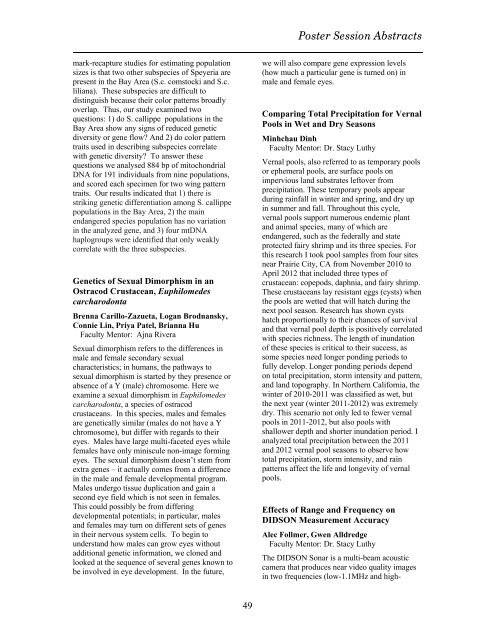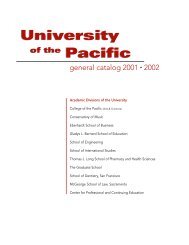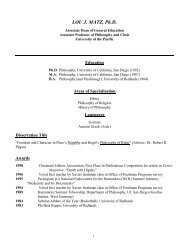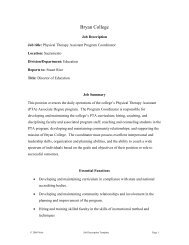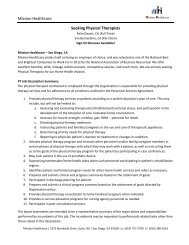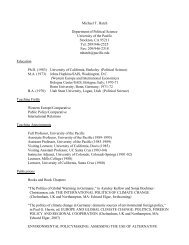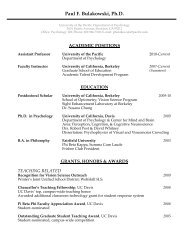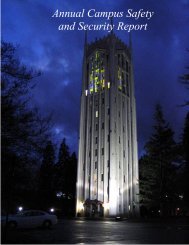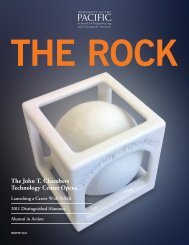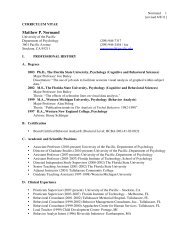purcc 2012 - University of the Pacific
purcc 2012 - University of the Pacific
purcc 2012 - University of the Pacific
You also want an ePaper? Increase the reach of your titles
YUMPU automatically turns print PDFs into web optimized ePapers that Google loves.
Poster Session Abstracts<br />
mark-recapture studies for estimating population<br />
sizes is that two o<strong>the</strong>r subspecies <strong>of</strong> Speyeria are<br />
present in <strong>the</strong> Bay Area (S.c. comstocki and S.c.<br />
liliana). These subspecies are difficult to<br />
distinguish because <strong>the</strong>ir color patterns broadly<br />
overlap. Thus, our study examined two<br />
questions: 1) do S. callippe populations in <strong>the</strong><br />
Bay Area show any signs <strong>of</strong> reduced genetic<br />
diversity or gene flow? And 2) do color pattern<br />
traits used in describing subspecies correlate<br />
with genetic diversity? To answer <strong>the</strong>se<br />
questions we analysed 884 bp <strong>of</strong> mitochondrial<br />
DNA for 191 individuals from nine populations,<br />
and scored each specimen for two wing pattern<br />
traits. Our results indicated that 1) <strong>the</strong>re is<br />
striking genetic differentiation among S. callippe<br />
populations in <strong>the</strong> Bay Area, 2) <strong>the</strong> main<br />
endangered species population has no variation<br />
in <strong>the</strong> analyzed gene, and 3) four mtDNA<br />
haplogroups were identified that only weakly<br />
correlate with <strong>the</strong> three subspecies.<br />
Genetics <strong>of</strong> Sexual Dimorphism in an<br />
Ostracod Crustacean, Euphilomedes<br />
carcharodonta<br />
Brenna Carillo-Zazueta, Logan Brodnansky,<br />
Connie Lin, Priya Patel, Brianna Hu<br />
Faculty Mentor: Ajna Rivera<br />
Sexual dimorphism refers to <strong>the</strong> differences in<br />
male and female secondary sexual<br />
characteristics; in humans, <strong>the</strong> pathways to<br />
sexual dimorphism is started by <strong>the</strong>y presence or<br />
absence <strong>of</strong> a Y (male) chromosome. Here we<br />
examine a sexual dimorphism in Euphilomedes<br />
carcharodonta, a species <strong>of</strong> ostracod<br />
crustaceans. In this species, males and females<br />
are genetically similar (males do not have a Y<br />
chromosome), but differ with regards to <strong>the</strong>ir<br />
eyes. Males have large multi-faceted eyes while<br />
females have only miniscule non-image forming<br />
eyes. The sexual dimorphism doesn’t stem from<br />
extra genes – it actually comes from a difference<br />
in <strong>the</strong> male and female developmental program.<br />
Males undergo tissue duplication and gain a<br />
second eye field which is not seen in females.<br />
This could possibly be from differing<br />
developmental potentials; in particular, males<br />
and females may turn on different sets <strong>of</strong> genes<br />
in <strong>the</strong>ir nervous system cells. To begin to<br />
understand how males can grow eyes without<br />
additional genetic information, we cloned and<br />
looked at <strong>the</strong> sequence <strong>of</strong> several genes known to<br />
be involved in eye development. In <strong>the</strong> future,<br />
we will also compare gene expression levels<br />
(how much a particular gene is turned on) in<br />
male and female eyes.<br />
Comparing Total Precipitation for Vernal<br />
Pools in Wet and Dry Seasons<br />
Minhchau Dinh<br />
Faculty Mentor: Dr. Stacy Luthy<br />
Vernal pools, also referred to as temporary pools<br />
or ephemeral pools, are surface pools on<br />
impervious land substrates leftover from<br />
precipitation. These temporary pools appear<br />
during rainfall in winter and spring, and dry up<br />
in summer and fall. Throughout this cycle,<br />
vernal pools support numerous endemic plant<br />
and animal species, many <strong>of</strong> which are<br />
endangered, such as <strong>the</strong> federally and state<br />
protected fairy shrimp and its three species. For<br />
this research I took pool samples from four sites<br />
near Prairie City, CA from November 2010 to<br />
April <strong>2012</strong> that included three types <strong>of</strong><br />
crustacean: copepods, daphnia, and fairy shrimp.<br />
These crustaceans lay resistant eggs (cysts) when<br />
<strong>the</strong> pools are wetted that will hatch during <strong>the</strong><br />
next pool season. Research has shown cysts<br />
hatch proportionally to <strong>the</strong>ir chances <strong>of</strong> survival<br />
and that vernal pool depth is positively correlated<br />
with species richness. The length <strong>of</strong> inundation<br />
<strong>of</strong> <strong>the</strong>se species is critical to <strong>the</strong>ir success, as<br />
some species need longer ponding periods to<br />
fully develop. Longer ponding periods depend<br />
on total precipitation, storm intensity and pattern,<br />
and land topography. In Nor<strong>the</strong>rn California, <strong>the</strong><br />
winter <strong>of</strong> 2010-2011 was classified as wet, but<br />
<strong>the</strong> next year (winter 2011-<strong>2012</strong>) was extremely<br />
dry. This scenario not only led to fewer vernal<br />
pools in 2011-<strong>2012</strong>, but also pools with<br />
shallower depth and shorter inundation period. I<br />
analyzed total precipitation between <strong>the</strong> 2011<br />
and <strong>2012</strong> vernal pool seasons to observe how<br />
total precipitation, storm intensity, and rain<br />
patterns affect <strong>the</strong> life and longevity <strong>of</strong> vernal<br />
pools.<br />
Effects <strong>of</strong> Range and Frequency on<br />
DIDSON Measurement Accuracy<br />
Alec Follmer, Gwen Alldredge<br />
Faculty Mentor: Dr. Stacy Luthy<br />
The DIDSON Sonar is a multi-beam acoustic<br />
camera that produces near video quality images<br />
in two frequencies (low-1.1MHz and high-<br />
49


